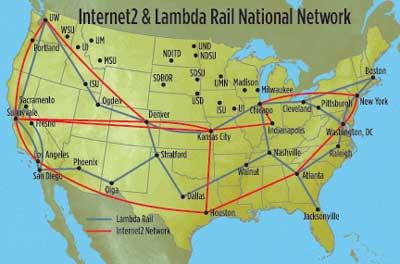More About Networks: A Regional Perspective
- By Annie Stunden
- 06/04/04
 I have just returned home from the spring Internet2 meeting, a gathering of
IT folks and the occasional faculty member from across the nation and around
the world. This is a meeting with a focus on research and education networking
nationally and internationally. It is a gathering where the focus is on taking
advantage of the capabilities of the Internet2 backbone network (a network that
is often called Abilene). The backbone for this network runs across the country
from New York and Washington to Los Angeles and Seattle. It also g'es south
through Atlanta and Houston. Universities and coalitions of universities then
build on ramps to Internet2. And thus we connect to our colleagues in other
universities around the country.
I have just returned home from the spring Internet2 meeting, a gathering of
IT folks and the occasional faculty member from across the nation and around
the world. This is a meeting with a focus on research and education networking
nationally and internationally. It is a gathering where the focus is on taking
advantage of the capabilities of the Internet2 backbone network (a network that
is often called Abilene). The backbone for this network runs across the country
from New York and Washington to Los Angeles and Seattle. It also g'es south
through Atlanta and Houston. Universities and coalitions of universities then
build on ramps to Internet2. And thus we connect to our colleagues in other
universities around the country.
Internet2 provides access to global networks that take our researchers around
the world. Today, a new high-speed research network is evolving in the United
States. It is known as National Lambda Rail (NLR). NLR is being designed not
only to move massive amounts of research data around the nation, but also to
allow researchers to do research on the network. It will be used for production
network purposes for researchers and to do research about networks. The map
of the U.S. shows the Internet2 network route and the proposed (and evolving)
route for NLR. But at the campus level, this national research network infrastructure
is only as good as our connections to it. And look at the map again. You can
see, we have a “last mile” problem, or for my friends in the Dakotas,
it’s a last hundreds of miles problem. As we look at exciting
applications that some folks are running across Internet2, it is clear to many
of us that we can’t do what those in Pittsburgh and Denver, those on the
main line, can do.
In Madison, it would not be wise to try to orchestrate a dance class with the
students in Madison and the choreographer in Corvallis. Sure, we can do video
over IP, but there is no guarantee of decent end-to-end performance. The faculty
member could get lost on the network, or have his head and his body in different
universes on the screen. No matter how well the students in Madison are performing,
the faculty member could be viewing dancers who are not moving in time to the
music and whose movements are extraordinarily choppy. The idea of a master class
using the network is fine. The successful implementation depends on the location
of the two end points.
And that’s simply one example of the challenge. At our state network
Future Technologies Forum, we had a great speaker, John Delaney from the University
of Washington. John is the program director of Neptune, a project to build an
undersea observatory off the West coast between Portland, Oregon, and Victoria,
BC, that allows observation of interactions between living and nonliving elements
under the sea. The intent of Neptune is to make the information and the experience
of undersea exploration available not only to scientists, but also to students,
from kindergarten to graduate programs. The capabilities for simulating undersea
environments and ocean exploration that Neptune will offer are boundless. For
our students and teachers in Wisconsin to take advantage of this phenomenal
opportunity, we need to be better connected throughout our state, to the national
research network infrastructure.
In Wisconsin, we have banded together with our colleagues in Minnesota, Iowa,
North Dakota, South Dakota, Montana, and Idaho in an attempt to build another
line on the national network infrastructure from Chicago to Seattle through
our states. We call ourselves the Northern Tier Network Consortium (NTNC). None
of us are the national leaders in building network infrastructure. We are figuring
this out as we go along, politically, financially, and technically.
Our colleagues in the northeast corner of the U.S.—New England and upstate
New York—are engaged in the same kind of process. The Northeast Research
and Educational Network (NEREN) initiative is trying to build great connectivity
for that part of the country to the advanced network points of presence in New
York City.
We all need to be able to take advantage of the great advancements in computing
and networking technology, the great work of scientists and scholars in this
country and worldwide. We need to make the learning and discovery process available
to students—in the cities and in the remote rural areas. National advanced
network infrastructure is one part of the support for that kind of access. Building
out the networks in our communities, our states, and our regions is the other
critical component. For universities and colleges, this kind of access is critical
to our mission.